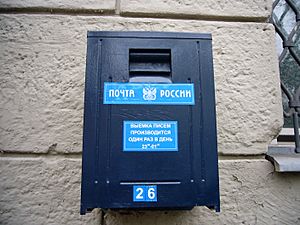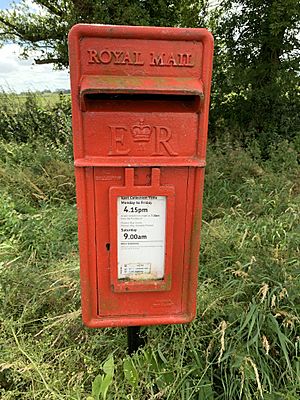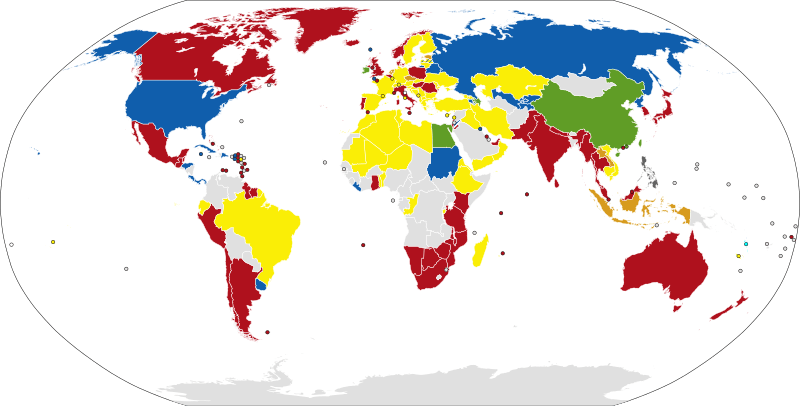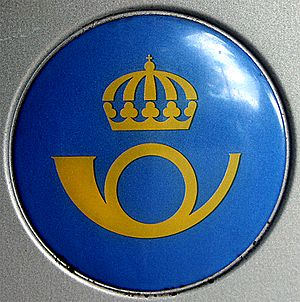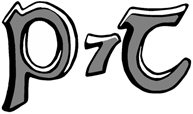Post box facts for kids
A post box (also called a mailbox or letter box) is a special container where people can drop off letters and packages they want to send. These boxes are usually found in public places like street corners or outside post offices. Postal workers then collect the mail from these boxes and deliver it to its destination. The term "post box" can also mean a private box for mail coming to your home.
Contents
A Look Back: History of Post Boxes
Europe's First Mailboxes
The idea of public post boxes started in Europe. In 1653, the first post boxes were likely set up in and around Paris, France. By 1829, they were common across France. Poland got its first public post boxes in Warsaw in 1842.
In Britain, the oldest known post box dates back to 1809. It was originally in the wall of the Wakefield Post Office and is now in the new Wakefield Museum.
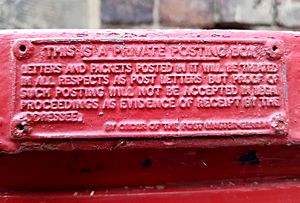
The first red pillar post boxes in the British Isles appeared in Guernsey in 1852. Soon after, in 1857, cheaper "wall boxes" were introduced, especially for country areas. The very first pillar box in the United Kingdom was placed in Carlisle in 1853.
At first, British post boxes were green. But between 1866 and 1879, they started painting them red. The first red boxes appeared in London in 1874. It took almost 10 years for all boxes to be repainted red! In 2012, to celebrate Olympic gold medals for Team GB, some special post boxes were painted gold.
In Russia, the first public post boxes appeared in St. Petersburg in 1848. They were made of wood and iron. Because they were light and easy to steal, later boxes were made of heavy cast iron, weighing up to 45 kilograms (about 100 pounds)!
-
A French wall box from 1977, now in a museum in Essex.
-
A modern postbox in Estonia.
-
A modern postbox in Poland.
-
A post box in Belgium.
Asian Post Box Stories
Post boxes arrived in Hong Kong in the late 1800s. They were first made of wood, then metal pillar boxes appeared in the 1890s. From the 1890s until 1997, Hong Kong's boxes were red. After 1997, they were painted green.
North American Mailboxes
The United States Post Office Department started putting public mailboxes outside post offices and on street corners in the 1850s. These early boxes were often hung on poles or buildings. By the 1880s, they were made of heavy cast iron to stop theft. As more mail was sent, larger, free-standing boxes replaced the smaller ones.
The familiar four-footed, free-standing "U.S. Mail" collection box was first suggested in 1894. It quickly became a common sight on U.S. city streets.
Unlike Canadian mailboxes, which were red, U.S. mailboxes were first red or green. In 1909, they all became dark green to avoid confusion with fire equipment. After World War I, they changed to olive drab green. Then, in 1955, they started painting them red, white, and blue to make them easy to spot. Later, they became red and blue with white letters. Since 1971, the United States Postal Service (USPS) has used dark blue with contrasting letters.
The invention of cars also changed mailbox design. In the late 1930s, "snorkel" boxes were added, allowing people to drop off mail from their cars.
-
USPS "Snorkel" collection boxes for drive-through access.
-
A USPS storage box in Venice, Los Angeles in 2018, showing the old olive green color used before 1955.
-
A post box in Markham, Ontario, Canada.
Africa's Unique Post Office Tree
In 1500, a Portuguese sea captain named Pêro de Ataíde faced a bad storm off the coast of South Africa. He wrote a message about the damage and a warning for other captains. He tucked the message into a boot hanging from a milkwood tree near a spring.
Amazingly, the message was found by the right person, João da Nova, the very next year! This tree became a natural "post office box." Sailors would leave letters there, hoping their countrymen would pick them up and deliver them, even if it took a long time.
The Post Office Tree, now about 600 years old, still "sends" and "receives" mail. A large post box shaped like a giant boot has been built under the tree. People can send letters from there and get a special stamp. Luckily, delivery now takes much less than a year!
Different Kinds of Post Boxes
There are several types of post boxes for sending mail:
- Lamp box
- Pillar box
- Wall box
- Ludlow wall box
Some postal services have different boxes for different types of mail. For example, some boxes are for regular mail, while others are for air mail or express mail. Some are for local addresses, and others are for out-of-town mail.
Countries also use different colors for their post boxes. In places like Australia, Portugal, and Russia, the color might tell you if it's for first-class or second-class mail. In Germany and parts of Sweden, different colors show which postal company will collect the mail. Other countries use certain colors because of their history or shared political ties.
Outdoor post boxes are built to keep mail safe and dry from weather. Many have rounded tops or slanted slots to protect mail from rain or snow. They have locks so only postal workers can get the mail. They are also built strong to resist damage. Bright colors help people see them easily. The openings are designed so mail can go in, but unauthorized people can't easily take it out.
-
A Royal Mail Lamp Box in Scotland, showing the Crown of Scotland instead of the usual symbol.
When Are Post Boxes Emptied?
Post boxes are emptied, or "cleared," at specific times, which are usually listed on a plate on the box. In cities, this might happen once or twice a day. Very busy boxes might be cleared more often so they don't overflow and to help postal workers sort the mail. Around Christmas, extra collections are made to handle all the holiday mail.
Since 2005, most Royal Mail post boxes in the UK only show the time of the last collection of the day. This is because they made the text larger for people with poor eyesight, and there wasn't enough space to list all the collection times. Some boxes have a small dial that shows the next collection time.
What Colors Are Post Boxes?
What Symbols Do Post Boxes Have?
- Australia – A red letter "P" (for "Post") on a white circle.
- Canada – A mix of a bird wing and an aircraft wing in a red circle, with "Canada Post" written next to it. Older boxes used to say "Royal Mail."
- Europe (most) – Many designs include a Post horn, like the ones postmen used to blow to announce their arrival. In Germany, the post horn is the main symbol for postal services.
- France – The arrow-shaped logo of La Poste.
- Greece – Hellenic Post uses the head of the god Hermes, who was known as the messenger of the gods.
- Netherlands – An orange triangle with "postnl" and a royal crown.
- Ireland – Since 1984, they use the An Post wavy lines logo. Older boxes had symbols like the Irish harp or "P&T" for Post and Telegraphs.
- Russia – The logo of Russian Post (Почта России) is white on blue, or black on yellow for first-class mail boxes.
- Spain – A Post horn with a royal crown on top.
- Japan – A "T" with a bar above it (〒).
- United Kingdom – All post boxes show the Royal Cypher (a special symbol of the king or queen) who was ruling when the box was made. However, boxes in Scotland made after 1952 show the Crown of Scotland instead of the Queen's symbol. Since 1994, Royal Mail post boxes also say "Royal Mail."
- United States – The United States Postal Service (USPS) eagle logo. Boxes for Express Mail use the USPS Express Mail logo.
Images for kids
-
"Priority Postbox" for returning COVID-19 home testing kits in Birmingham, England, November 2020.
See also
 In Spanish: Buzón para niños
In Spanish: Buzón para niños


